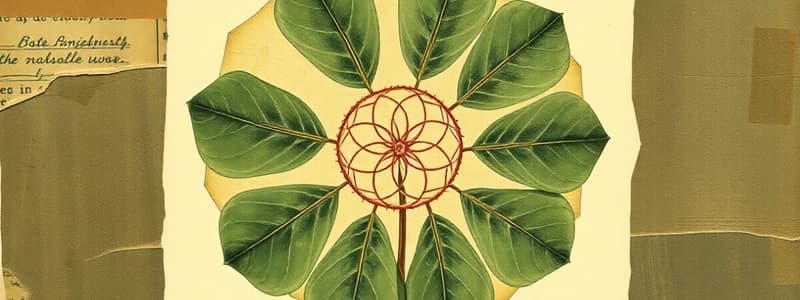Podcast
Questions and Answers
What are osteosclereids most commonly found in?
What are osteosclereids most commonly found in?
- Leaves of monocots
- Seed coat and fruit wall (correct)
- Vascular tissue
- Root epidermis
What shape are astrosclereids?
What shape are astrosclereids?
- Cuboid shaped
- Irregular shaped
- Star shaped (correct)
- Round shaped
Which type of fibers is associated with the xylem?
Which type of fibers is associated with the xylem?
- Phloem fibers
- Cortical fibers
- Extraxylary fibers
- Xylary fibers (correct)
What characterizes tracheids in xylem?
What characterizes tracheids in xylem?
How does water move from cell to cell in tracheids?
How does water move from cell to cell in tracheids?
What is indicated by bordered pits in tracheids?
What is indicated by bordered pits in tracheids?
What are the two kinds of primary xylem tissue?
What are the two kinds of primary xylem tissue?
Where can you typically find glandular trichomes?
Where can you typically find glandular trichomes?
What is the primary function of promeristem in plants?
What is the primary function of promeristem in plants?
Which type of parenchyma is specifically involved in photosynthesis?
Which type of parenchyma is specifically involved in photosynthesis?
What is the function of xylem fibers in plants?
What is the function of xylem fibers in plants?
What is the characteristic feature of transfer cells?
What is the characteristic feature of transfer cells?
Which component of the phloem tissue is responsible for transporting sugars?
Which component of the phloem tissue is responsible for transporting sugars?
Which type of sclereid is known to be isodiametric in shape and found in fruit pulp?
Which type of sclereid is known to be isodiametric in shape and found in fruit pulp?
What differentiates metaxylem from protoxylem?
What differentiates metaxylem from protoxylem?
What is the function of aerenchyma tissue in plants?
What is the function of aerenchyma tissue in plants?
Glandular cells are specialized parenchyma cells that primarily serve what function?
Glandular cells are specialized parenchyma cells that primarily serve what function?
What role do companion cells play in phloem tissue?
What role do companion cells play in phloem tissue?
Which of the following describes the function of xylem parenchyma?
Which of the following describes the function of xylem parenchyma?
Which type of collenchyma provides structural support with minimal metabolic requirements?
Which type of collenchyma provides structural support with minimal metabolic requirements?
What role do parenchyma cells play in repair and regeneration?
What role do parenchyma cells play in repair and regeneration?
Which structure in phloem tissue has no organelles at functional maturity?
Which structure in phloem tissue has no organelles at functional maturity?
What is the primary function of vascular cambium?
What is the primary function of vascular cambium?
Which component of xylem is involved in conducting water?
Which component of xylem is involved in conducting water?
Flashcards are hidden until you start studying
Study Notes
Plant Tissue Types
- Promeristem: Gives rise to meristems responsible for growth.
Ground Tissue Functions
-
In roots:
- Perceives gravity, determining root growth direction.
- Produces mucilage for soil penetration.
- Forms protective sheath around root tips.
-
Parenchyma:
- Functions in photosynthesis and organic product storage.
- Capable of cell division for repair and regeneration.
Special Types of Parenchyma
-
Chlorenchyma:
- Photosynthetic parenchyma with abundant chloroplasts.
- Thin cell walls facilitate light and CO2 passage.
-
Glandular Cells:
- Secrete nectar, resins, and oils.
- Contain few chloroplasts but numerous dictyosomes and endoplasmic reticulum.
-
Transfer Cells:
- Short-distance transport of materials with convoluted walls.
- Increases cell membrane surface area for enhanced transport.
-
Aerenchyma:
- Tissue with large intercellular spaces for gas exchange.
- Provides support with minimal energy use.
Sclerenchyma Types
-
Brachysclereids (stone cells):
- Isodiametric shape in fruit pulp and coconut pericarp.
-
Macrosclereids:
- Rod-like structures found in leguminous bark and seed coats.
-
Osteosclereids:
- Bonelike sclereids present in seed coats and fruit walls.
-
Astrosclereids:
- Star-shaped sclereids located in the leaves of dicots and gymnosperms.
Fibers
-
Xylary Fibers: Associated with xylem, providing structural support.
-
Extraxylary Fibers: Associated with cortex and phloem, including phloem fiber caps.
Vascular Tissue Composition
- Epidermis: Protective outer layer.
- Xylem and Phloem Tissues: Two primary conducting systems.
Xylem Tissue Classification
-
Primary Xylem: Originates from procambium.
- Protoxylem: First formed xylem elements.
- Metaxylem: Differentiated from protoxylem.
-
Secondary Xylem: Produced by vascular cambium.
Xylem Components
- Xylem Parenchyma: Living cells for storage and lateral transport.
- Xylem Fibers: Sclerenchyma fibers forming wood.
Phloem Structure
-
Sieve Tube Members: Living cells responsible for sugar transport, lack organelles.
-
Companion Cells: Assist sieve tube members in sugar loading and unloading.
Phloem Associated Tissue
- Phloem Parenchyma: Thin-walled cells near sieve tubes for support.
- Phloem Fibers: Sclerenchyma fibers provide additional support forming the phloem fiber cap.
Studying That Suits You
Use AI to generate personalized quizzes and flashcards to suit your learning preferences.




